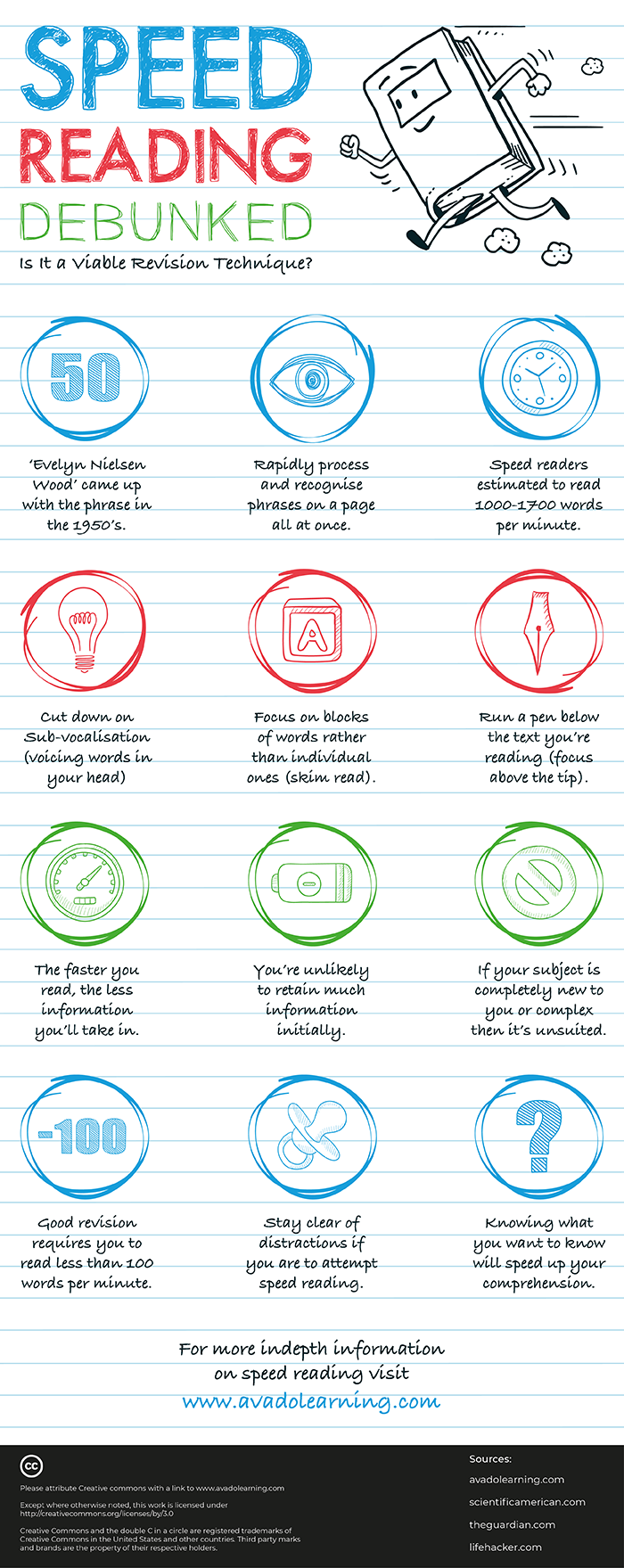
What is Speed Reading?
‘Speed Reading’ is the process where instead of identifying individual words, the reader will rapidly process and recognise phrases on a page all at once. The technique is nothing new, as speed reading has been touted as a genuine skill since the 1950s when Evelyn Nielsen Wood first coined the phrase. In more recent times, there’s been a number of cheap apps and web browsing extensions that train you in the art of speed reading. Some of the most popular include:
- OpenSpritz: An extension that uses a technique called ‘Spritz’ (we’ll cover that later) that flashes words on your screen, highlighting one letter of each word at a time. This supposedly keeps your eye position even to benefit the speed of your reading.
- Spreed: This extension is built for Chrome and is similar to OpenSpritz as it also flashes the desired words on your screen. It doesn’t, however, highlight each individual letter
- Velocity/Outread/Syllable: Velocity and Syllable use a Speed Reading variation called RSVP and Outread uses meta guiding. We’ll look at these variations later on
Some will be naturally quicker than others, but on average people read at a rate of around 200-400 words per minute (wpm). The ability to speed read would theoretically allow you to double this rate. The average words per minute a Speed Reader can digest is claimed to be around 1000-1700 words per minute.
This would undoubtedly seem attractive to someone looking to cram as much revision in a small space of time, so let’s look further into the technique to see if it’s actually beneficial to your studies.
How to Speed Read
Before we go into the art of speed reading, we need to understand how we normally comprehend text. Slate.com broke down what we know about reading well in this passage of text:
“When you factor out the amount of time spent thinking through complex and unfamiliar concepts—a rarity when people read for pleasure—reading is an appallingly mechanical process. You look at a word or several words. This is called a “fixation,” and it takes about 0.25 seconds on average. You move your eye to the next word or group of words. This is called a “saccade,” and it takes up to about 0.1 seconds on average. After this is repeated once or twice, you pause to comprehend the phrase you just looked at. That takes roughly 0.3 to 0.5 seconds on average. Add all these fixations and saccades, and comprehension pauses together, and you end up with about 95 percent of all college-level readers reading between 200 and 400 words per minute.”
Speed readers theoretically reduce the time they use to fixate on words by cutting down on something called ‘sub-vocalisation’. Sub-vocalisation is how we all pronounce and hear what we read in our head (what you’re doing now). Instead, speed readers will ‘skim read’ lines of text.
How to Study With Different Speed Reading Methods
One way of approaching speed reading is a variation of it called ‘The Scanning Method’. Like all speed variations, this will fundamentally reduce the amount of sub-vocalising you do while reading. To do this, try focusing on blocks of words rather than individual ones. To achieve this you’ll need to be in a relaxed environment, with a soft and expanded gaze at the page you’re reading. This will help you avoid seeing words as single obstacles to overcome. Then as you approach the end of a line, allow your peripheral vision (eyesight that occurs outside the point of fixation, i.e. away from the centre of gaze) to guide your eye to the final set of words. This should help reduce those pauses and sub-vocalisation. With practice, your eyes will be able to glide over the page faster.
Other variations of speed reading are ‘The Pointer Method’ and ‘The Tracker-And-Pacer Method’. ‘The Pointer Method’ was the original way of approaching speed reading in the 50s when Evelyn Nielsen Wood pioneered the technique. It’s as simple as running your finger or a piece of card under the lines of text as you go along. Evelyn claimed she could read up to 2,700 words per minute with this simple trick.
‘The Tracker-And-Pacer Method’ is very similar to ‘The Pointer Method’, as you run a pen underneath the text you’re reading. You can keep the pen cap on or underline the text with this technique. The idea behind the benefit to this variation is that you focus your eye above the tip of the pen, which consequently improves your focus on the words.
When to Speed Read
We know speed reading will help you read quicker, but is it an appropriate technique for when you’re revising? The most effective speed reading will be being able to comprehend the text you’re reading at a higher than average pace. The faster you read, the less information you’re likely to take in as studies have shown. With this in mind, if what you’re revising is a technical or complex document, then speed reading isn’t suited to you. Similarly, if you’re revision is of a subject that is completely new to you, or you have to teach someone this knowledge, then speed reading is not the answer here.
Keith Rayner’s book ‘Eye Movements And Information Processing During Reading’ claims that speed reading isn’t possible as our eyes can’t read that way;
“You can probably push yourself to get a little over 500 words per minute, but you’re limited by the eyes and the anatomy of the retina. To understand text you need to move your eyes to put the fovea on the part of the text you want to focus. Acuity drops off pretty markedly outside the fovea, and you can’t discriminate the words and text far from the fovea. So, that’s the rate limited factor, as is how fast the brain can process information.”
However, if you only need to understand basic arguments and information presented to you, speed reading can massively help you cram all of that information in a short time. This is especially true if you need to re-read something when you’re perhaps less busy/distracted.
The impact speed reading has on your revision will vary from person to person. As generally speaking if you need to memorise a big portion of information, you’ll need to read it slowly at a rate less than 100 words per minute (as opposed to the 1000+ words per minute speed reading can produce). You’ll only know if it’s right for you by experimenting with the technique with portions of the text you’re revising.
Find Revision Strategies When Speed Reading
Decided to give speed reading a go? Here are some final tips to make sure you’re reaping all the benefits from speed reading during revision:
- Stay Clear Of Distractions. Place yourself in an environment where there are few if any distractions (that includes switching off phone notifications), in order for your undivided attention to be on the words in front of you.
- Take Baby Steps Initially. As discussed huge and complex text might not be ideal for speed reading, so at least at first, use the technique to revise simple articles or a few pages just until you get used to the technique.
- Cover Up The Words You’ve Read. This will further increase the focus you have on the words you’ve yet to read.
- Know What You Want To Know. As you’ll be skimming through the text, it can be beneficial to decide beforehand what you want to find out from the text. This will allow you to breeze over words and phrases that you know are irrelevant to the task at hand.
- Record Your Progress And Practice. Test yourself on passages of text using both the speed reading technique and without to see if there has been any improvement to memory of what you’ve revised. Finally like everything in life, the more you practice speed reading, the better you’ll be at it.
If you’re curious about what your current reading speed is, there’s an online test you can take by Staples.




